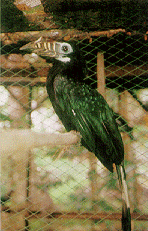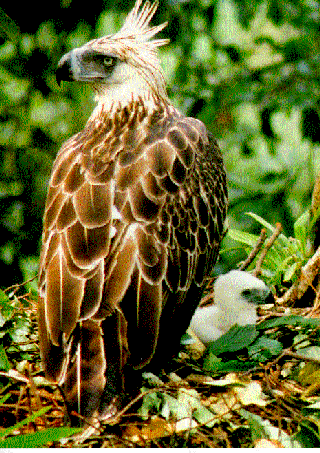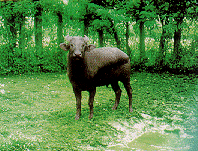Faunal Diversity in Philippine Forests
 n estimated 1,084 species of terrestrial vertebrates are found in Philippine forests, of which 45 percent are endemic. Of these, 179 species are mammals with 61 percent endemism, 15 of which are still in the process of being named.
n estimated 1,084 species of terrestrial vertebrates are found in Philippine forests, of which 45 percent are endemic. Of these, 179 species are mammals with 61 percent endemism, 15 of which are still in the process of being named.  There are 558 species of birds are mammals with 61 percent endemism, 15 of which are still in the process of being named. There are 558 species of birds recorded in the country with 31 percent endemism, 38 percent of which are confined to single islands. About 71 percent are known to breed in a diversity of habitats from beach to montane forests but there are no breeding information on 40 percent of these breeding species.
There are 252 species of reptiles wity 63 percent endemism. There are four major subgroups of reptiles: the lizards (126 species, 75 percent endemism), snakes (112 species, 54 percent endemism), turtles (10 species, 10 percent endemism), and crocodiles (two species, 50 percent endemism). A total of 96 amphibian species are recognized taxonomically in the country, namely: with 53 endemism. Most are also single-island endmics. Of these, four were introduced species in the country, namely: the marine toad (Bufo marinus), the American bullfrog (Rana catesbeiana, the leopard frog (R. Tigrina), and the Taiwanese frog (R. rugolosa). The marine toad was introduced in the 1930s to control sugarcane beetle infestation while the last three were introduced for breeding and export as food. These species have escaped from captivity and are now widespread throughout the country. Their impact on indigenous species and the ecosystem, in general, are unknown.
There are 558 species of birds are mammals with 61 percent endemism, 15 of which are still in the process of being named. There are 558 species of birds recorded in the country with 31 percent endemism, 38 percent of which are confined to single islands. About 71 percent are known to breed in a diversity of habitats from beach to montane forests but there are no breeding information on 40 percent of these breeding species.
There are 252 species of reptiles wity 63 percent endemism. There are four major subgroups of reptiles: the lizards (126 species, 75 percent endemism), snakes (112 species, 54 percent endemism), turtles (10 species, 10 percent endemism), and crocodiles (two species, 50 percent endemism). A total of 96 amphibian species are recognized taxonomically in the country, namely: with 53 endemism. Most are also single-island endmics. Of these, four were introduced species in the country, namely: the marine toad (Bufo marinus), the American bullfrog (Rana catesbeiana, the leopard frog (R. Tigrina), and the Taiwanese frog (R. rugolosa). The marine toad was introduced in the 1930s to control sugarcane beetle infestation while the last three were introduced for breeding and export as food. These species have escaped from captivity and are now widespread throughout the country. Their impact on indigenous species and the ecosystem, in general, are unknown.
The number of species of millipedes and centipedes is 54 and 44, respectively, while more than 20,000 species of insects have been identified. However, only the lacewings, fleas, caddisflies, two-winged flies, and butterfly species have been fully inventoried.
There are 341 species of spiders found in rice and non-rice habitats, which is less than two percent of the world's total. However, many more species remain to be discovered and identified, since more than 75 percent of these are new to science and live on habitats that have not been fully explored.
So far, 2,782 species of mollusks have been identified in all of the country’s ecosystems. However, the level of endemism is undetermined but estimated to range from high to very high.
The level of endemism of invertebrates is generally poorly known but is suspected to be high. Endemism ranged from 44 percent to 87 percent with a mean of 64 percent for the six insect orders inventoried.
 Eighty six species of birds found in the country are under various forms of threat, from being vulnerable to being extinct in the wild. Of these, 45 species are either extinct in the wild, critical, or endangered. Forty of the 45 aforementioned species are endemic, which makes the Philippines the number one country in the world in terms of number of threatened endemic species of birds.
Eighty six species of birds found in the country are under various forms of threat, from being vulnerable to being extinct in the wild. Of these, 45 species are either extinct in the wild, critical, or endangered. Forty of the 45 aforementioned species are endemic, which makes the Philippines the number one country in the world in terms of number of threatened endemic species of birds.
In contrast, 30 species of terrestrial mammals are classified under various threat categories, from being rare to being endangered, while only two species of amphibians and three species of reptiles in the Philippine forests are classified under various threatened categories. This number is definitely a conservative estimate as little information about these three groups, as a whole, is known.
The most threatened endemic mammal is the tamaraw,  Bubalus mindorensis, while the most threatened endemic bird is the Philippine eagle, Pithecophaga jefferyii. Both species are estimated to have a wild population of less than 200 each. Both are also the subject of captive breeding studies with very limited success.
Bubalus mindorensis, while the most threatened endemic bird is the Philippine eagle, Pithecophaga jefferyii. Both species are estimated to have a wild population of less than 200 each. Both are also the subject of captive breeding studies with very limited success.
